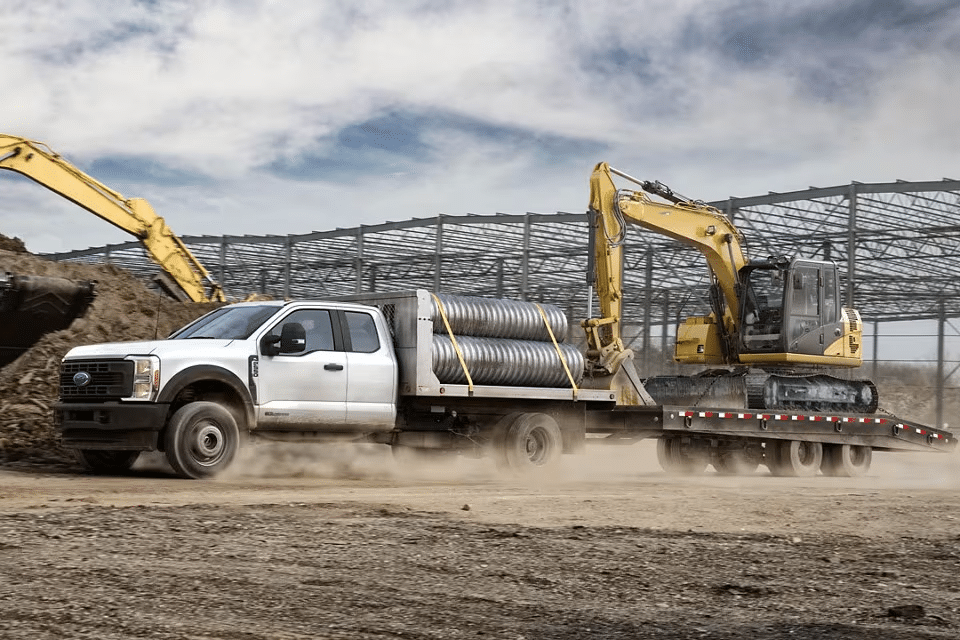Towing Guide

Ford Towing Guide
Discover all you need to know to tow with confidence, whether you’re new to towing or a seasoned pro.
Get on Board with Connected Services
From light-duty to heavy-duty, explore the towing capabilities of various Ford vehicles. See the Ford vehicle Towing Guides for more details.
- Light Towing
- Medium Towing
- Heavy Towing

Small Loads, Big Power
Ideal for lighter loads between 680 kg (1,500 lbs) to 1,814 kg (4,000 lbs), Ford’s light-duty vehicles are perfect for towing a small boat, trailer, ATVs and more.
Explore your options:
Bronco Sport
Escape
Maverick

Serious Loads, Serious Strength
Tow heavy-duty loads from over 2,268 kg (5,000 lbs) to 18,143 kg (40,000 lbs) like motor homes, box trucks, dump trucks, tractor trailers, and even heavy machinery. For F-150 and Super Duty trucks, a fifth wheel or gooseneck hitch can also make the job of heavy towing easier.
Explore your options:
F-150
Expedition
F-150 Lightning
Super Duty
Try the F-Series Towing Calculator (VIN required).
Factors that Impact Towing

Engine
Horsepower and torque work together to deliver high-end and low-end power, respectively. Torque will help to get your vehicle moving from a standstill when towing. Meanwhile, horsepower will help with acceleration at high speeds, such as when passing on a highway.
*Horsepower and torque are independent attributes and may not be achieved simultaneously.
Transmission
Towing can cause strain on your transmission as it works harder than normal to handle the extra weight and resistance. You can help manage this by maintaining the correct transmission fluid level and scheduling regular fluid changes.
Braked and Unbraked
Braked towing capacity is the maximum your vehicle can tow when the trailer has its own brakes. This capacity is higher than your vehicle’s unbraked towing capacity – when the trailer lacks its own brakes. A vehicle can tow heavier loads under control when the trailer can brake independently.
Download Ford Towing Guides
Find towing information for various Ford vehicles, including trailer weights and towing packages.
Towing FAQs
Find answers to common towing questions.
While the Gross Vehicle Weight (GVW) of a vehicle is the Base Curb Weight plus actual cargo weight and passengers, GVWR stands for Gross Vehicle Weight Rating. It represents the maximum weight a vehicle is designed to safely carry, including its weight, passengers, cargo, and accessories. Towing capacity refers to the maximum weigh a vehicle can safely tow behind it. This weight includes the trailer being towed and any cargo loaded onto the trailer.
While GVWR and towing capacity relate to a vehicle’s ability to carry weight, they differ. GVWR is about the total weight the vehicle can handle while towing capacity is the weight the vehicle can pull behind it.
GCVWR stands for Gross Combined Vehicle Weight Rating. It represents the maximum allowable weight of the tow vehicle and the trailer it is towing, including all cargo, passengers, fuel, and accessories.
To calculate the GCVWR, refer to the specifications shown on the vehicle’s Safety Compliance Certification Label, located on the driver’s side door lock facing or the door latch post pillar, or in the Ford Owner’s Manual.
Once you have the GCVWR, you can determine the maximum weight at which your combination tow vehicle and trailer can safely operate, ensuring that you do not exceed this limit to maintain safe towing conditions.
To calculate your vehicle’s GCVWR and maximum payload rating, locate these key specifications:
- Look for the labels below on the driver’s side B-pillar of the doorjamb. GCVWR is stated here in kilograms and pounds.
- Maximum payload rating is also located on the doorjamb in kilograms and pounds.
GAWR stands for Gross Axle Weight Rating. It is the maximum weight that each axle on a vehicle is designed to support.
The GAWR is calculated using a label inside the driver’s side door jamb or in the vehicle’s owner’s manual.
Once you have the GAWR for each axle, you can determine the maximum weight that can be placed on each axle without exceeding its capacity. This helps ensure safe handling and performance of the vehicle, preventing overloading that could lead to mechanical failures or accidents.
When loading cargo or passengers onto a vehicle, it’s essential to distribute the weight evenly between the axles and ensure that the total weight does not exceed the GAWR for any individual axle.
Curb weight refers to the total weight of a vehicle, including all standard equipment, fluids (such as fuel and oil), and a full gas tank, but excluding any passengers or cargo. It represents the vehicle’s weight in its factory condition, ready for operation on the road.
To calculate the curb weight of a vehicle, you need to refer to the specifications provided by Ford. The curb weight is often listed on a label inside the driver’s side door jamb, in the Ford Owner’s Manual.
Payload capacity refers to the maximum weight of cargo and passengers that a vehicle is designed to carry.
Payload Capacity: To calculate a vehicle’s payload capacity, you typically subtract the curb weight from the Gross Vehicle Weight Rating (GVWR). The result is the maximum weight of passengers and cargo that the vehicle can safely carry. Payload Capacity = GVWR – Curb Weight.
Towing capacity refers to the maximum weight a vehicle is rated to tow behind it.
To calculate the towing capacity of a vehicle, you need to refer to the specifications provided by Ford. The towing capacity is listed in the Ford Owner’s Manual or on a label inside the driver’s side door jamb. The towing capacity represents the maximum weight that the vehicle can safely tow behind it, including the weight of the trailer and any cargo.
Tongue weight refers to the downward force exerted on the hitch ball by the trailer coupler. It’s an important factor in towing safety as it affects the stability and handling of the tow vehicle and trailer combination.
To calculate tongue weight:
- Calculate the tongue weight: Multiply the loaded trailer weight by the desired percentage (10-15%) to determine the recommended tongue weight.
- Determine the percentage of tongue weight: Generally, tongue weight should be about 10-15% of the trailer’s total loaded weight. However, this percentage can vary depending on trailer design, load distribution, and towing conditions.
- Measure the trailer’s loaded weight: Fully load it as it would be for towing, including all cargo, gear, and fluids. Use a vehicle scale or specialized trailer tongue weight scale to accurately measure the trailer’s total weight.
Already an Owner?
Get towing tips and information for your Ford vehicle.
Towing Calculator
Discover the towing capabilities of your F-Series vehicle with our convenient towing calculator.

